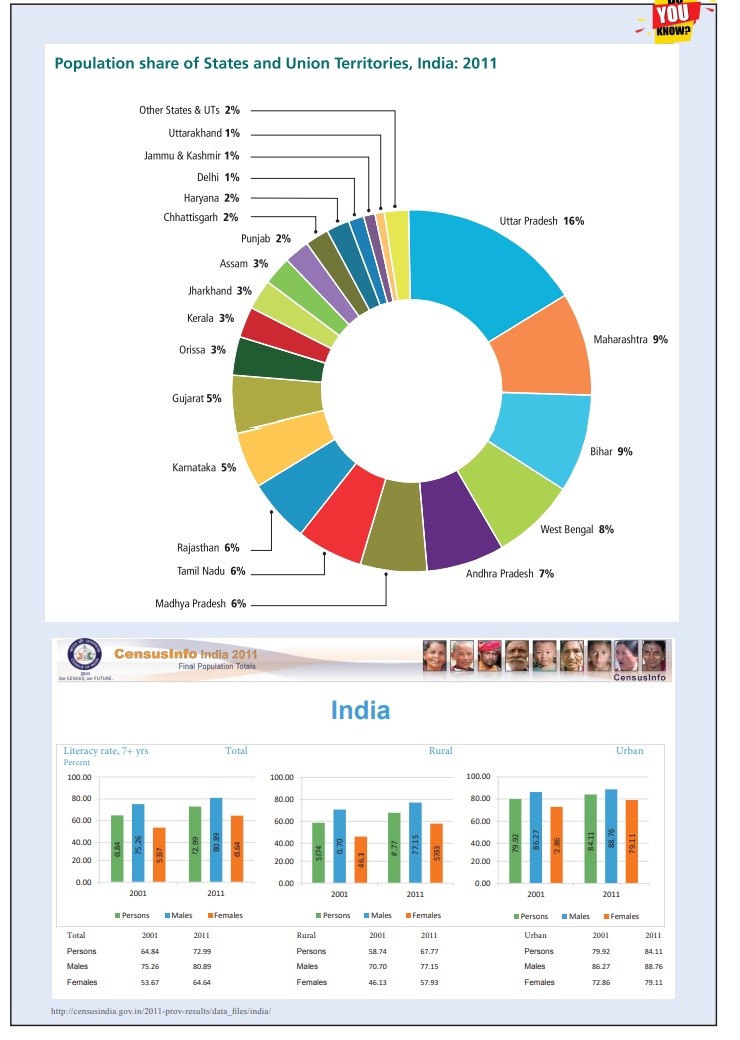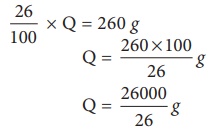Term 3 Chapter 2 | 7th Maths - Percentage in Real Life | 7th Maths : Term 3 Unit 2 : Percentage and Simple Interest
Chapter: 7th Maths : Term 3 Unit 2 : Percentage and Simple Interest
Percentage in Real Life
Percentage in Real Life
We have seen how percentage are used
in comparison of quantities. We also learnt to convert fractions and decimals to
percentage and vice-versa.
Now we shall see some situations that
use percentage in real life such as 5% of income is allotted for saving; 20% of
children’s picture book is coloured green; a book distributor gets 10% of profit
on every book sold by him. What can we conclude from these situations.
Percentage as a value
Example 2.14
There are 50 students in a class. If 14% are absent on a particular
day, find the number of students present
in the class.
Solution:
Number of students absent on a particular
day =
14 % of 50
= 14/100 ×50= 7
Therefore, the number of students present
=
50 −
7 =
43 students.
Example 2.15
Kuralmathi bought a raincoat
and saved ₹ 25 with discount of 20%. What was the original price of the raincoat?
Solution:
Let the price of the raincoat (in ₹ )
be P. So 20% of P = 25
(20/100) × P = 25
P = (25 ×100) /20 = 125
Therefore, the original price of the
raincoat is ₹ 125.

Example 2.16
An alloy contains 26 % of
copper. What quantity of alloy is required to get 260 g of copper ?
Solution:
Let the quantity of alloy required be
Q g
Then 26 % of Q =260 g

[26/100] ×
Q = 260 g
260/100 × Q = 260
g
Q = (260 × 100) / 26 g
Q = 26000
/ 26 g
Q = 1000 g
Therefore, the required quantity of alloy
is 1000 g.
Ratios as percentage
Sometimes ingredients used to prepare
food can be represented in the form of ratio. Let us see some examples.
Example 2.17
Kuzhal’s mother makes dosa
by mixing the batter made from 1 portion of Urad dhal with 4 portions of rice. Represent each of the ingredients
used in the batter as percentage.
Solution:
Representing ingredients used in the
batter as ratio, we get, rice : urad dhall = 4 : 1
Now, the total number of parts is 4 +
1 =
5 .
That is, 4/5 portion of rice is mixed
with 1/5 portion of urad dhall.
Thus, the percentage of rice would be 4/5 ×100%
= 400/5 %= 80%
The percentage of urad dhall would be
1/50 ×100% = 100/5 %= 20%
Example 2.18
A family cleans a house for
pongal celebration by dividing the work in the ratio 1:2:3. Express each portion of work as percentage.
Solution:
The total
number of parts of the work is 1 + 2 + 3 = 6
That is, the
work is divided into 3 portions as 1//6,2/6 and 3/6.
Thus, the percentage of 1/6 th portion
of work would be 1/6 ×100% = 100/6 %=16 (2/3) %
Similarly, the percentage of 2/6 th portion
of work would be 1/2 × 100% = 200/6 %= 33 (1/3) %
Similarly,
the percentage of 3/6 th portion of work would be 3/6 ×
100% =
300/6 % =
50%
Increase or decrease as Percentage
There are situations where we need to
know the increase or decrease of a certain quantity as percentage. Let us see few
examples.
Example 2.19
During Aadi sale the price
of shirt decreased from ₹ 90 to ₹ 50. What is the percentage of decrease.
Solution:
Original price
= the price of the shirt before Aadi month
Amount of
change = the decrease in the price = 90 – 50 = ₹ 40
Therefore,
the percentage of decrease = [ Amount of change / Original amount ] ×100
= 40/90 ×100 = 400/9
= 44 (4/9) %
Example 2.20
The number of literate persons
in a city increased from 5 lakhs to 8 lakhs in 5 years. What is the percentage of increase?
Solution:
Original amount
= the number of literate persons initially = 5 lakhs
Amount of
change = increase in the number of literate persons = 8 – 5 = 3 lakhs
Therefore,
the percentage of increase = ( Amount of
change/ Original amount ) ×100
= 3/5 ×100 = 60%
Try these
Level of water in a tank
is increased from 35 litres to 50 litres in 2 minutes, what is the percentage of
increase?
Profit or Loss as a Percentage
We have learnt already profit and loss
of items. Now we will see how a profit or loss can be converted to percentage. That
is, to find the profit % or loss %, we will see some examples.
Example 2.21
A shopkeeper bought a chair
for ₹ 325 and sold it for ₹ 350. Find the profit percentage.
Solution:
Profit per cent = ( Profit / C.P ) ×100
= (25/325) × 100 = 100/13 = 7 (9/13) %.
Example 2.22
A T-shirt bought for ₹ 110
is sold at ₹ 90. Find the loss percentage.
Solution:
Cost price
of T-shirt is ₹ 110 and Selling price is ₹ 90. So, the loss is ₹ 20
Hence, for
₹ 100 the loss is 20/110 ×100 = 200×11 = 18 (2/11)% .
Example 2.23
An item was sold at ₹ 200 at a loss of 4 %. What is its cost price.
Solution:
To find the
cost price,
Loss per cent
= [ Loss / C.P ] ×100
4% = [ Loss
/ C.P ] ×100
4% = Loss/200
×100
Loss = 8
C.P = S.P
+ Loss
= 200+8
= 208
Hence the
cost price of the item is ₹ 208.
The world's population
is growing by 1.10 % per year.
50.4 % of the world's population is male and 49.6 % is female.
Related Topics